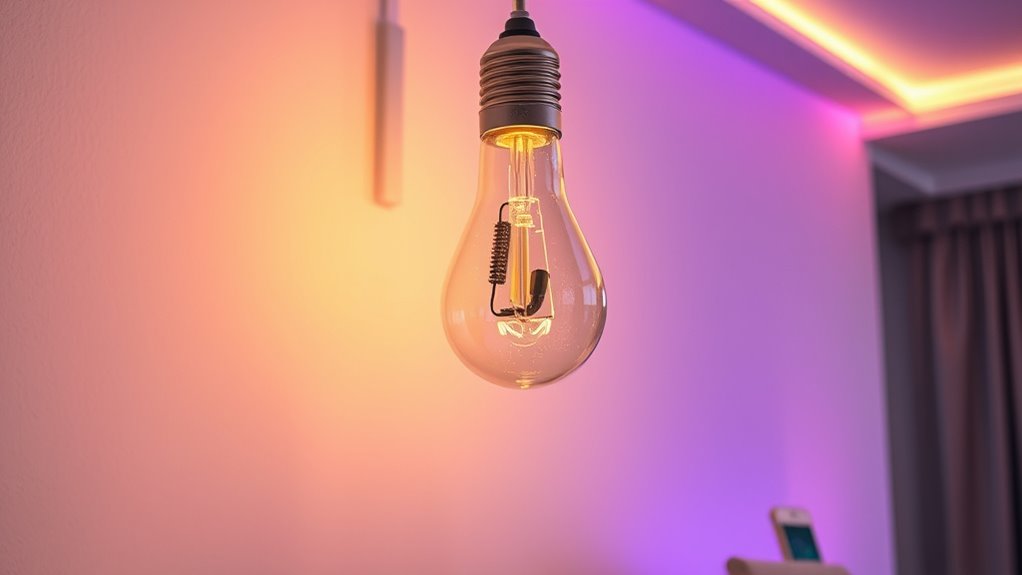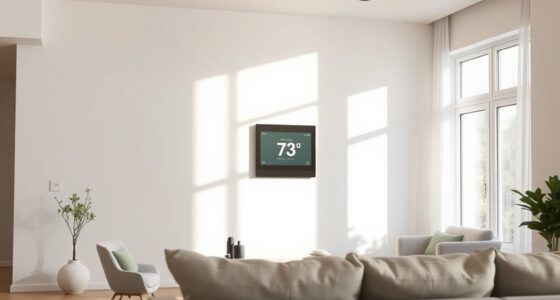Smart light bulbs connect via Wi-Fi, Bluetooth, or Zigbee, allowing easy control through apps and voice commands, and support features like scheduling and scene setting. Installation is simple—you unscrew the old bulb, guarantee compatibility, and follow app prompts for pairing. They offer customizable colors, brightness, and automation, making your home more convenient and energy-efficient. Curious about which models are best or how to maximize their benefits? Keep exploring for all the smart lighting secrets.
Key Takeaways
- Proper installation and app setup ensure seamless connectivity and easy control via smartphones or voice assistants.
- Compatibility with protocols like Wi-Fi, Zigbee, or Z-Wave impacts setup complexity and ecosystem integration.
- Features such as customizable colors, scheduling, and scenes enhance ambiance, convenience, and energy savings.
- Smart bulbs offer long-term value through energy efficiency, durability, and advanced automation, reducing replacement costs.
- Staying updated on standards like Matter guarantees future-proofing and broad compatibility in evolving smart home ecosystems.
How Do Smart Light Bulbs Operate?
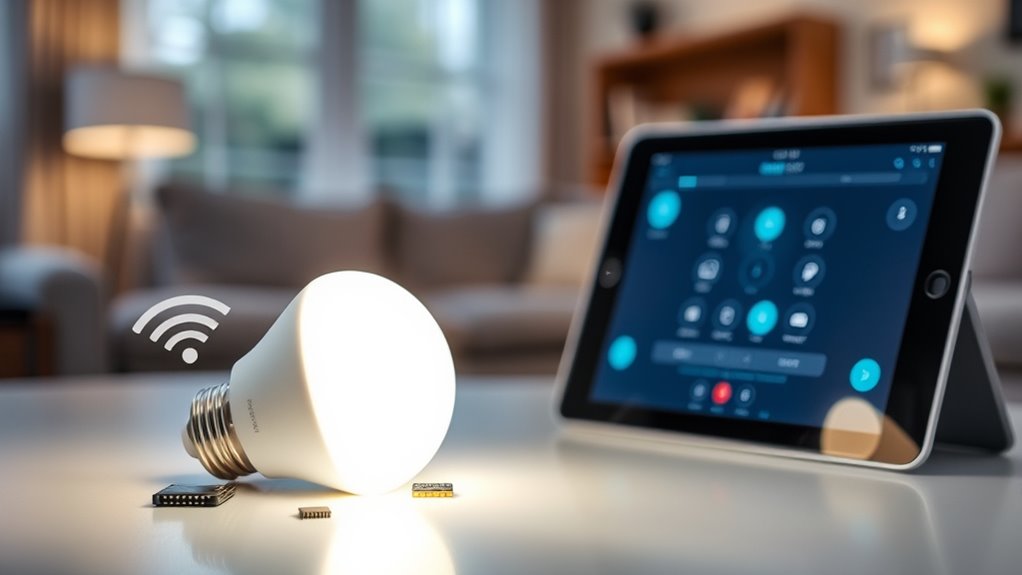
Smart light bulbs operate by connecting to your home network using Wi-Fi, Bluetooth, Zigbee, or Z-Wave, allowing you to control them remotely. This connectivity enables you to turn lights on or off, adjust brightness, and change colors through smartphone apps or voice commands with virtual assistants like Alexa or Google Assistant. Many smart bulbs support scheduling features, so you can automate lighting routines, such as setting lights to turn on at sunset or off when you leave home. Installation usually involves replacing your standard bulbs with smart ones that connect directly or via a hub to your network. This seamless connectivity makes managing your lighting simple and convenient, giving you full control over your environment from anywhere. Additionally, some smart bulbs incorporate safety features like flicker detection and overheat protection to ensure reliable operation. Understanding wireless communication protocols can help you choose the best smart bulb for your setup and ensure compatibility with your existing smart home devices. Furthermore, understanding energy efficiency can help you select bulbs that save power and reduce electricity bills.
Setting Up Your Smart Light Bulb Step-by-Step
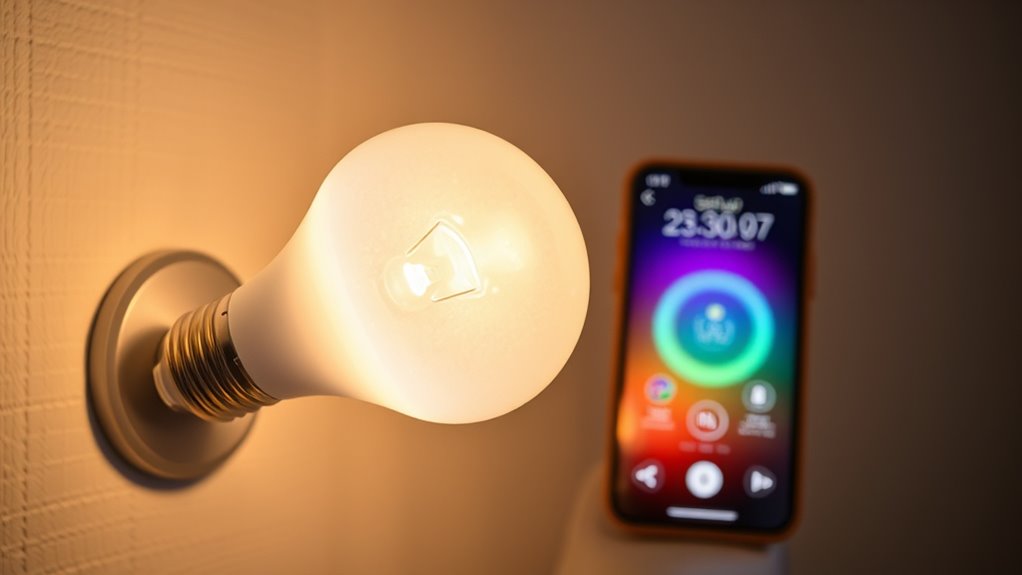
To set up your smart light bulb, start by preparing your installation area and removing the old bulb. Next, download the appropriate app for your bulb and follow the pairing instructions to connect it to your Wi-Fi. A new spiritual insight can help guide you through understanding the symbolism behind angel numbers during setup. Additionally, considering the best hotels with water parks in Orlando can inspire relaxing vacation ideas to enjoy once your setup is complete. When configuring your device, it’s also helpful to review the privacy and cookie policies, ensuring your data and preferences are protected throughout the process. Finally, customize the settings in the app, like brightness and color, to get everything just right. Be sure to check the installation instructions carefully, as some smart bulbs may have specific setup requirements.
Prepare Installation Area
Are you ready to prepare your installation area for your new smart light bulb? First, turn off the light switch and remove the existing bulb to guarantee safety. Check that your smart bulb’s base matches your light fixture—common bases include E26 or E27—and confirm the bulb shape fits your lamp or fixture. Screw the smart bulb firmly into the socket, but avoid over-tightening to prevent damage. Once installed, turn the light switch back on to power the bulb. Make sure the location has a stable Wi-Fi or Bluetooth signal for the best connectivity and control. Choosing a suitable spot ensures your smart home setup functions smoothly, giving you full control of your lighting with ease. Understanding mental wellbeing can also help you create a calming environment that promotes relaxation and enhances your overall experience with smart technology. Additionally, ensuring the installation environment is free from obstructions and interference can improve connectivity and device performance. Being mindful of industry trends can also help you select the most compatible and feature-rich smart bulbs for your setup. Considering lighting customization options can further enhance your control and personalize your space to suit your mood or activities. Furthermore, paying attention to privacy considerations can help protect your personal data and ensure a secure smart home experience.
Download and Install App
Once you’ve installed your smart bulb and confirmed it’s working properly, the next step is to download the app that controls it. To do this, follow these steps:
- Visit the Apple App Store or Google Play Store and search for your smart bulb’s brand.
- Tap “Download app” and wait for it to install on your device.
- Open the app, then follow the prompts to create an account or log in with your details.
- Be aware that security vulnerabilities in new technologies can expose your device to risks, so ensure your app and device software are up to date.
- Additionally, choosing a reputable app for your specific smart bulb model can improve performance and security, ensuring a smoother setup experience.
- Remember to review the app’s privacy policies to understand how your data is handled during setup and operation.
- To enhance your experience, consider integrating smart home devices, which can improve overall control and functionality of your smart lighting system.
- Using secure Wi-Fi networks can help safeguard your device from unauthorized access during setup and daily use.
Make sure your device is connected to Wi-Fi, as this will help with the pairing process. Once the app is installed, you’ll be ready to move on to connecting your bulb and customizing its settings.
Connect and Customize Settings
After installing the app and logging in, you can begin connect and customizing settings for your smart bulb. First, follow the app’s instructions to pair the bulb—this may involve connecting to Wi-Fi, scanning a QR code, or entering a pairing code. Once connected, name your bulb for easy identification. You can then customize settings like brightness, color, and scenes directly within the app. These options allow you to create the perfect ambiance for any moment. To make it even smarter, link your bulb to voice assistants like Alexa, Google Assistant, or Siri through the app’s integration options. Here’s a quick overview:
| Step | Action |
|---|---|
| Connect | Pair the bulb with your app and Wi-Fi |
| Name | Label your bulb for easy access |
| Customize Settings | Adjust brightness, color, and scenes |
Adding the ability to set schedules and automate lighting can further enhance your experience by providing comfort and support solutions tailored to your daily routine. Understanding how to pair your smart bulb effectively can improve your setup process and ensure seamless operation. Additionally, exploring smart home integration can help you maximize the functionality of your lighting system. Incorporating yoga practices can also help you create a relaxing environment that complements your smart lighting setup.
Ideal Locations for Smart Light Bulbs
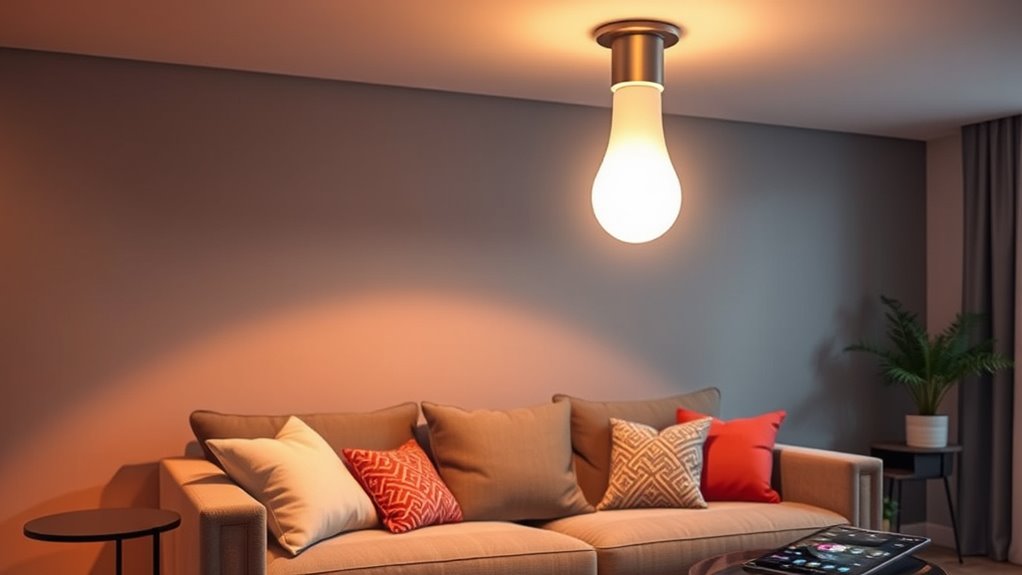
Smart light bulbs work best in areas where you want convenient control and automation, such as living rooms, bedrooms, and home offices. These spaces benefit from smart lights that can be easily dimmed, color-adjusted, or scheduled. Imagine:
- A cozy bedroom with adjustable lighting for relaxation.
- A lively living room with customizable scenes for movie nights.
- A productive home office with consistent lighting that won’t be interrupted by wall switches.
Smart bulbs are ideal for fixtures like table lamps and floor lamps that are constantly powered, ensuring reliable operation of your lighting devices. They’re less suited for overhead ceiling fixtures unless smart switches are installed. Placing smart lights in these key areas enhances ambiance, convenience, and security, especially when understanding city dynamics helps optimize your home setup.
Key Features to Consider When Choosing a Smart Bulb
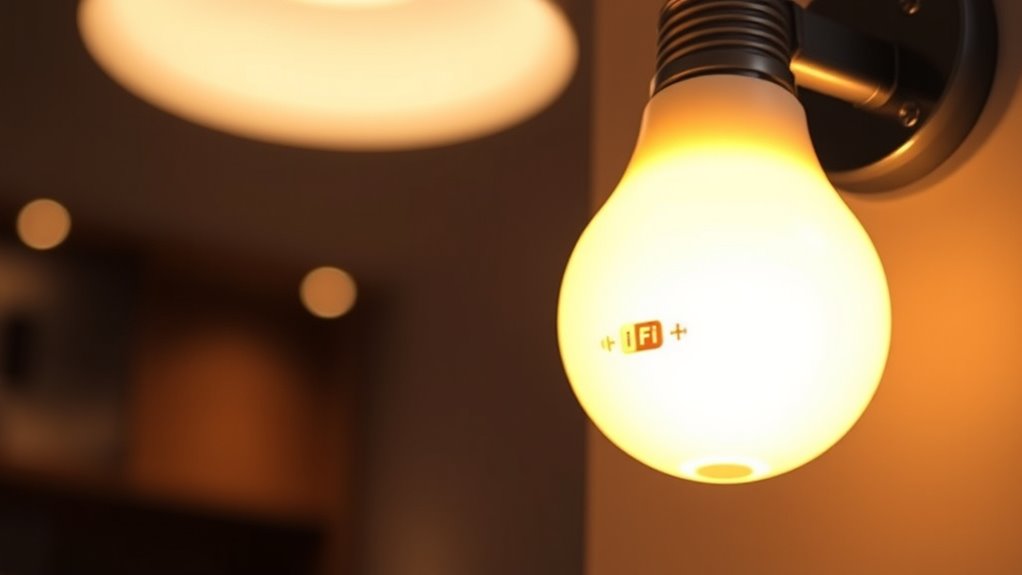
When selecting a smart light bulb, focusing on its key features guarantees you get the best fit for your needs. Brightness, measured in lumens, is essential; choose a bulb that matches your room size and desired illumination, with options ranging from 450 to 1,600 lumens. The ability to connect easily is also important—consider whether the bulb connects directly via Wi-Fi or requires a hub, as this impacts setup and reliability. Customization features like color options, with some bulbs supporting up to 16 million colors, allow you to tailor ambiance to your liking. Compatibility with voice assistants such as Alexa, Google Assistant, or Siri simplifies control and automation. Additional features like scheduling, scenes, and music sync can further enhance your smart lighting experience.
Comparing Popular Smart Light Bulb Models
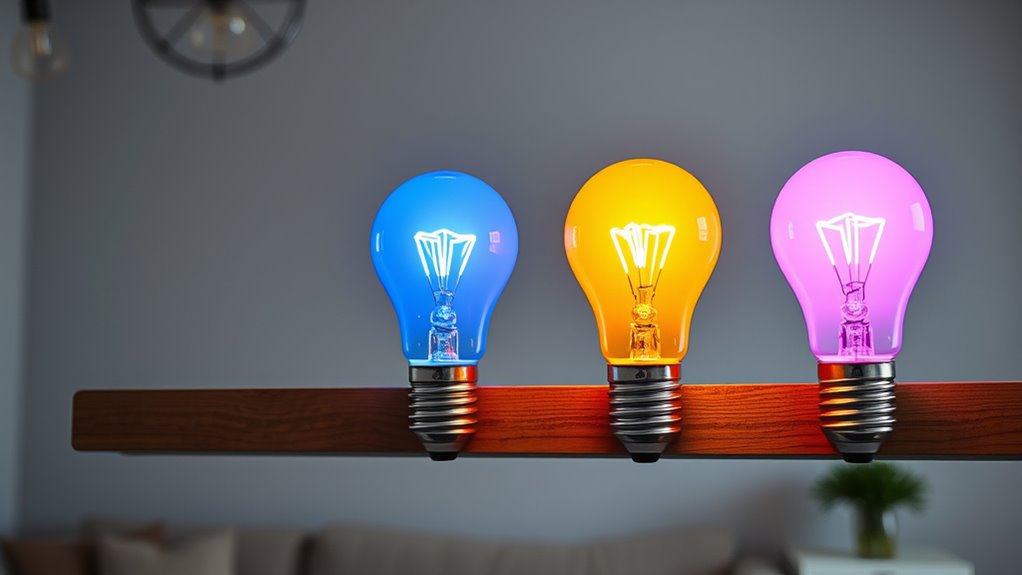
Choosing the right smart light bulb depends on your specific needs and how you plan to use it. If you want vibrant colors and broad platform support, the WiZ 60W A19 Color LED offers extensive options, multiple scenes, and compatibility with Alexa, Google, and Siri, all for about $11. For seamless Apple Home integration and quick responses, the Meross MSL120 is a solid choice, priced at around $29 for a two-pack. If you prefer straightforward control with scheduling and Scenes, the RCA Smart Wi-Fi A19 delivers that at roughly $25 for two bulbs. Meanwhile, the U-tec Bright A19 1100LM is ideal for large spaces, featuring mesh Wi-Fi connectivity and high brightness at about $17 each. These models differ mainly in connectivity, automation features, and price points.
Understanding Connectivity and Ecosystem Compatibility
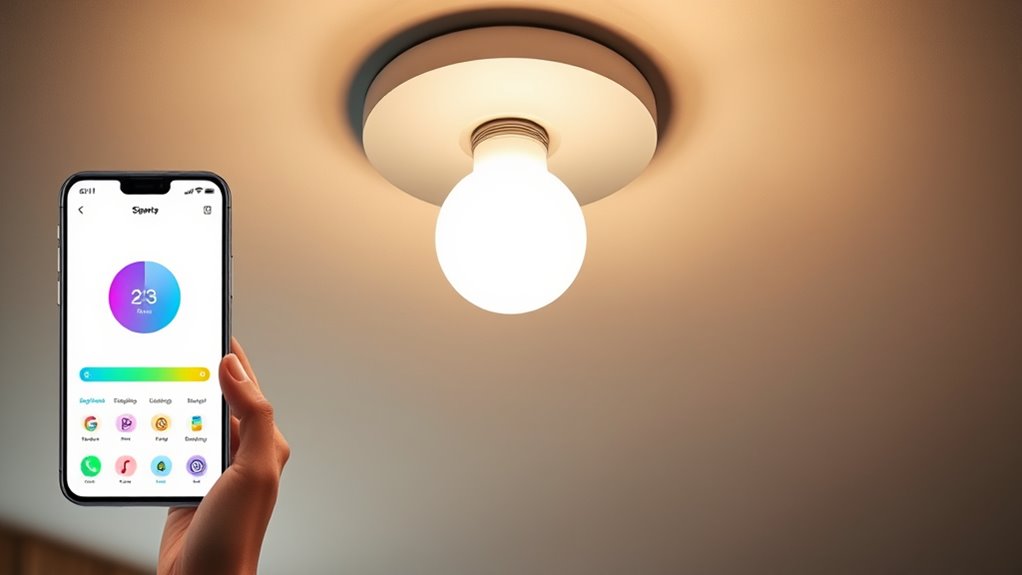
Your smart bulb’s connectivity options determine how easily you can control it, whether through Wi-Fi, Bluetooth, Zigbee, or Z-Wave. Compatibility with voice assistants and ecosystems like SmartThings or Apple HomeKit affects how smoothly your devices work together. Understanding protocols and integration helps you choose bulbs that fit seamlessly into your existing setup.
Connectivity Options Overview
Have you ever wondered how smart bulbs connect to your home? Most use one of three main options:
- Wi-Fi, which allows direct connection to your network, needing no hub and enabling easy setup.
- Zigbee, a protocol that requires a hub or bridge, creating a mesh network for reliable, large-scale control.
- Bluetooth or Z-Wave, which also need hubs but offer varied range and compatibility.
Wi-Fi smart bulbs are popular for their simplicity, directly communicating with your router. Zigbee bulbs, on the other hand, depend on hubs that connect to your Wi-Fi, expanding coverage. Compatibility with voice assistants like Alexa or Google Assistant often hinges on these connectivity choices.
Ecosystem Compatibility Range
Understanding the ecosystem compatibility of smart bulbs is essential because it determines how well they integrate with your existing smart home systems. Different smart bulbs use protocols like Wi-Fi, Bluetooth, Zigbee, or Z-Wave, which influence their compatibility with various platforms. Some brands, such as U-tec and Meross, support multiple ecosystems including SmartThings, Apple HomeKit, and Google Home, offering flexible integration options. Wi-Fi-based smart bulbs usually provide broader compatibility with your home network but might require specific apps for full features. Compatibility with voice assistants like Alexa, Google Assistant, or Siri varies depending on the brand and protocol. Choosing smart bulbs with the right ecosystem compatibility ensures seamless control across multiple platforms, simplifying your smart home setup and enhancing your user experience.
Protocols and Integration
Smart light bulbs connect through various protocols like Wi-Fi, Bluetooth, Zigbee, or Z-Wave, each offering different advantages in range, speed, and compatibility. When choosing, consider these key points:
- Wi-Fi bulbs connect directly to your home network, eliminating the need for a hub, making setup straightforward.
- Zigbee bulbs require a compatible hub or bridge, but they excel in mesh networks, providing reliable coverage across large homes.
- Ecosystem compatibility matters; for example, Philips Hue uses Zigbee, compatible with platforms like Alexa and Google Assistant, while LIFX operates over Wi-Fi for easy integration.
Understanding these protocols helps you select bulbs that fit your existing smart home setup. Whether prioritizing direct Wi-Fi access or mesh network stability with Zigbee, your choice impacts ease of use and ecosystem compatibility.
Benefits of Using Smart Light Bulbs in Your Home

Ever wondered how smart light bulbs can make your home more efficient and comfortable? With smart lights, you can schedule them to turn on or off automatically, saving energy and offering convenience. They allow you to customize colors and brightness levels, helping you set the perfect mood in any room. Integrated with voice assistants, managing your lighting becomes hands-free, so you don’t need to constantly flip the light switch. These bulbs also last up to 50,000 hours, reducing replacement costs over time. Plus, you can enhance your home security by remotely controlling lights and setting timers to mimic occupancy when you’re away. Overall, smart bulbs improve comfort, save energy, and boost security, making your home smarter and more adaptable to your lifestyle.
Cost Analysis: Are Smart Bulbs Worth the Investment?
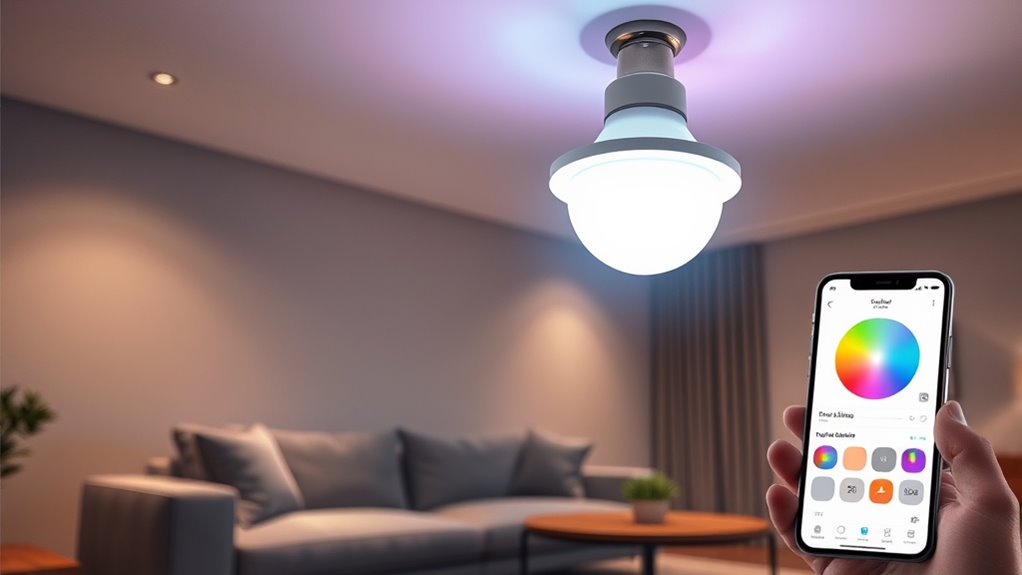
Smart bulbs typically cost more upfront than traditional LEDs, but their long lifespan and energy savings can make them a smart investment. You’ll need to weigh the initial expense against potential savings over time, especially with energy-efficient features that cut costs. Ultimately, whether they’re worth it depends on how much you value convenience and long-term benefits.
Upfront Cost Vs Savings
Is the higher upfront cost of smart light bulbs justified by the savings they offer over time? Absolutely, if you consider the long-term benefits. Imagine:
- Paying $11 to $29 per bulb upfront, compared to traditional LEDs, which are cheaper initially but less advanced.
- Enjoying energy savings of 25-80%, which cut your electricity bills considerably.
- Benefiting from a lifespan of up to 50,000 hours, reducing replacement costs and waste.
While the initial investment might seem steep, many users find that smart bulbs pay for themselves within 1-2 years thanks to lower energy consumption and added convenience. Over time, these savings outweigh the upfront costs, making smart bulbs a smart investment.
Long-Term Energy Benefits
Although the upfront cost of smart bulbs may seem high, their long-term energy savings make them a worthwhile investment. Smart bulbs consume about 25-80% less energy than traditional incandescent bulbs, which lowers your electricity bills over time. Their long lifespan, up to 50,000 hours, means fewer replacements and reduced costs. While they may cost between $2 and $60 per bulb initially, the energy savings and durability quickly offset these expenses within a few years. Additionally, features like scheduling and automation help prevent unnecessary usage, further decreasing energy consumption and costs. Over the long term, investing in smart bulbs offers significant energy benefits, making them a smart financial choice for households looking to improve efficiency and cut ongoing lighting expenses.
Typical Lifespan and Durability of Smart LED Bulbs
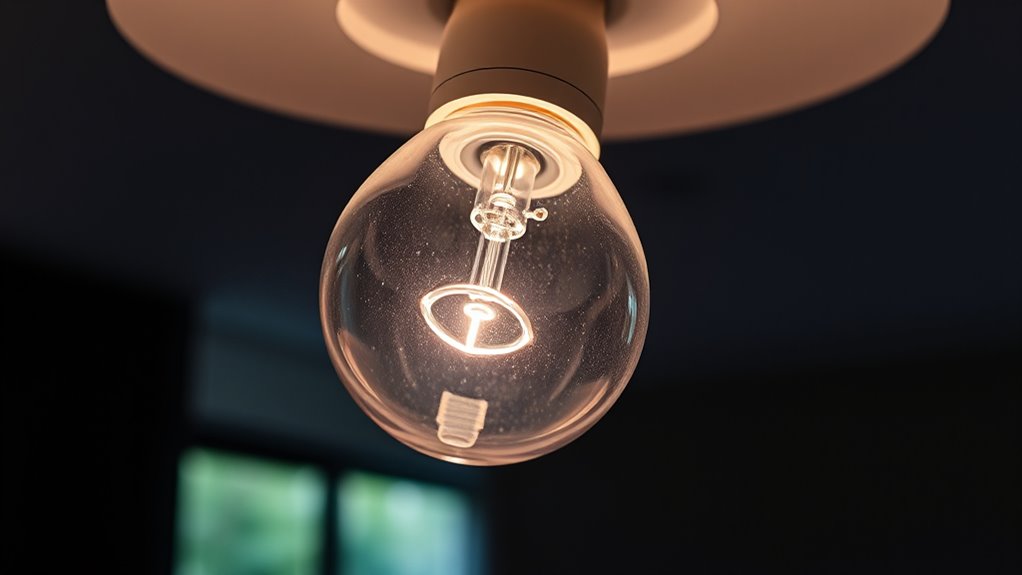
The typical lifespan of smart LED bulbs far exceeds that of traditional incandescent bulbs, often reaching up to 50,000 hours of use. This impressive durability means you can enjoy years of reliable lighting without frequent replacements. To maximize your LED smart bulb’s durability, consider these key points:
- High-quality components extend the bulb’s operational life.
- Proper installation prevents early wear and tear.
- Avoiding frequent power surges maintains consistent performance.
Unlike incandescent bulbs, which burn out quickly, smart LEDs gradually dim over time, emphasizing their longevity. The durability of your smart bulb largely depends on its build quality and careful handling. Most manufacturers back their LED smart bulbs with warranties of 3-5 years, reflecting confidence in their long-term performance. With proper care, you’ll enjoy consistent, energy-efficient illumination for many years, making smart LED bulbs a worthwhile investment.
Future Trends and Potential Obsolescence of Smart Lighting
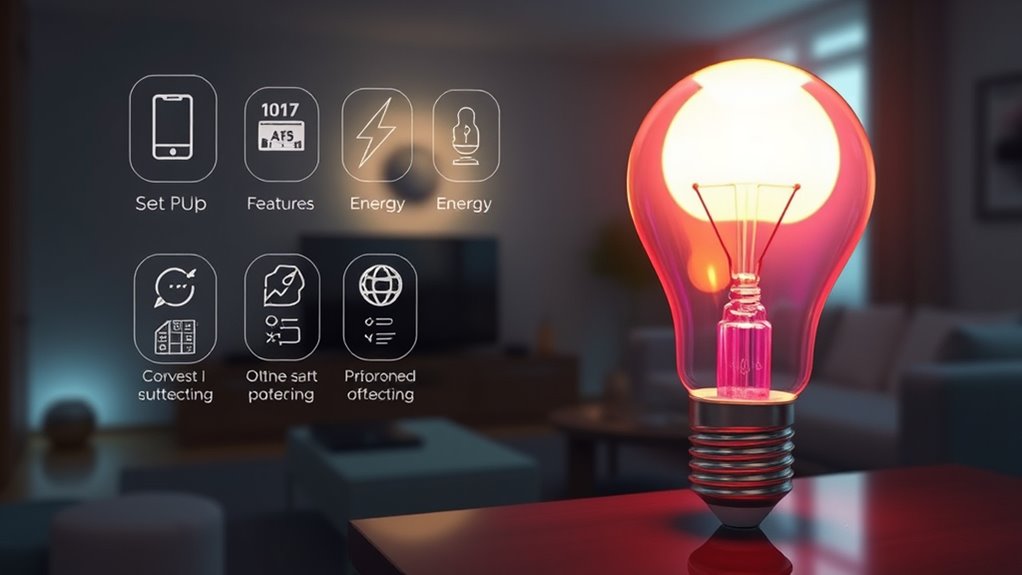
As smart lighting technology advances, emerging standards like Matter are set to improve device compatibility and guarantee your smart bulbs remain functional over the long term. These future standards aim to unify communication protocols, reducing obsolescence risks. With traditional incandescent bulbs phased out globally, smart LED bulbs are becoming the new norm, possibly making older, non-smart lighting options obsolete. Additionally, AI and automation advancements could make smart lighting systems more autonomous, diminishing manual control’s relevance. The rapid evolution of smart home ecosystems may also cause older devices or outdated protocols to become incompatible. Manufacturers might introduce centralized, multi-functional fixtures that replace standalone bulbs, further accelerating obsolescence.
| Future Standards | Impact on Obsolescence |
|---|---|
| Matter | Improved compatibility |
| AI & Automation | Reduced manual control |
| Multi-functional Fixtures | Phasing out standalone bulbs |
Frequently Asked Questions
Is It Worth Getting Smart Bulbs?
You’re wondering if smart bulbs are worth it. If you value convenience, energy savings, and automation, they definitely are. You’ll enjoy remote control, scheduling, and voice commands, making your life easier. Although the upfront cost is higher, long-term savings on energy bills and their durability make them a smart investment. If you like integrating technology into your home, smart bulbs are a worthwhile upgrade that enhances comfort and efficiency.
What Can You Do With Smart Light Bulbs?
Imagine transforming your space into a haven of comfort and convenience. With smart light bulbs, you can effortlessly change colors, dim lights, and create personalized scenes that suit your mood or activity. You control everything through your phone or voice commands, set schedules, and sync lighting with music or movies. They even respond to your presence, turning on or off automatically, making your environment more inviting and secure.
What Are the Disadvantages of Smart Light Bulbs?
You should consider the disadvantages of smart light bulbs, as they can be costly and may require extra hardware or complex setup processes that challenge your technical skills. They rely on Wi-Fi and cloud services, raising privacy and security concerns. Compatibility issues with existing switches or fixtures can limit their functionality, and ongoing costs for replacements or subscriptions might add up, making them less practical for some users.
What Are the Features of Smart Bulbs?
Did you know over 80% of smart bulb users enjoy customizable lighting? You’ll find features like adjustable brightness and color-changing options that let you set the perfect mood. Many smart bulbs support scheduling, timers, and automation, so your lights can turn on or off automatically. Compatibility with voice assistants like Alexa or Google Assistant makes controlling them effortless. Some even sync with music or adjust to your circadian rhythms for a truly personalized experience.
Conclusion
So, after uncovering the secrets of smart light bulbs, you’re now equipped to outwit your old-fashioned bulbs and bask in the glow of convenience. Sure, they promise a futuristic home, but don’t forget—they might just outlive your patience or become obsolete faster than you can say “app update.” Still, if you enjoy the thrill of controlling your lighting with a tap or voice command, then these bulbs are definitely worth the upgrade—until the next tech craze, of course.
